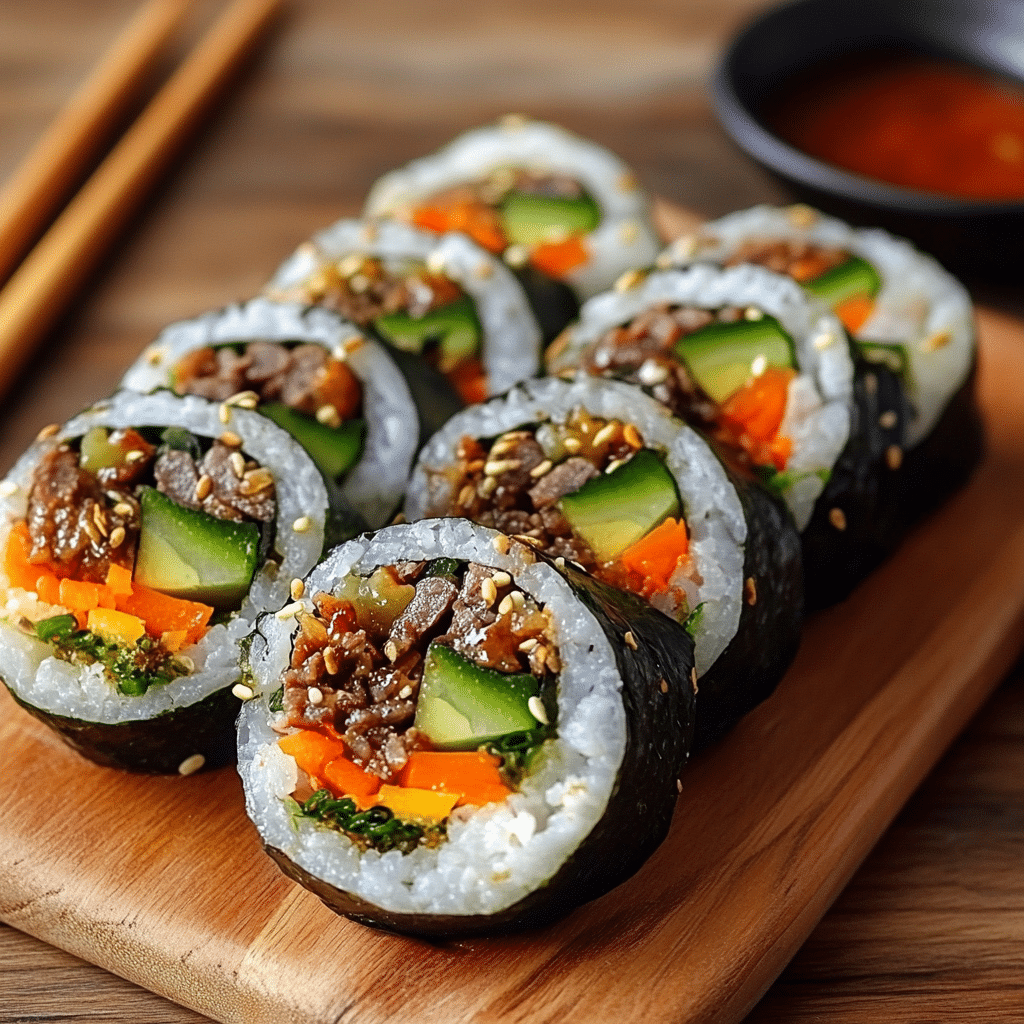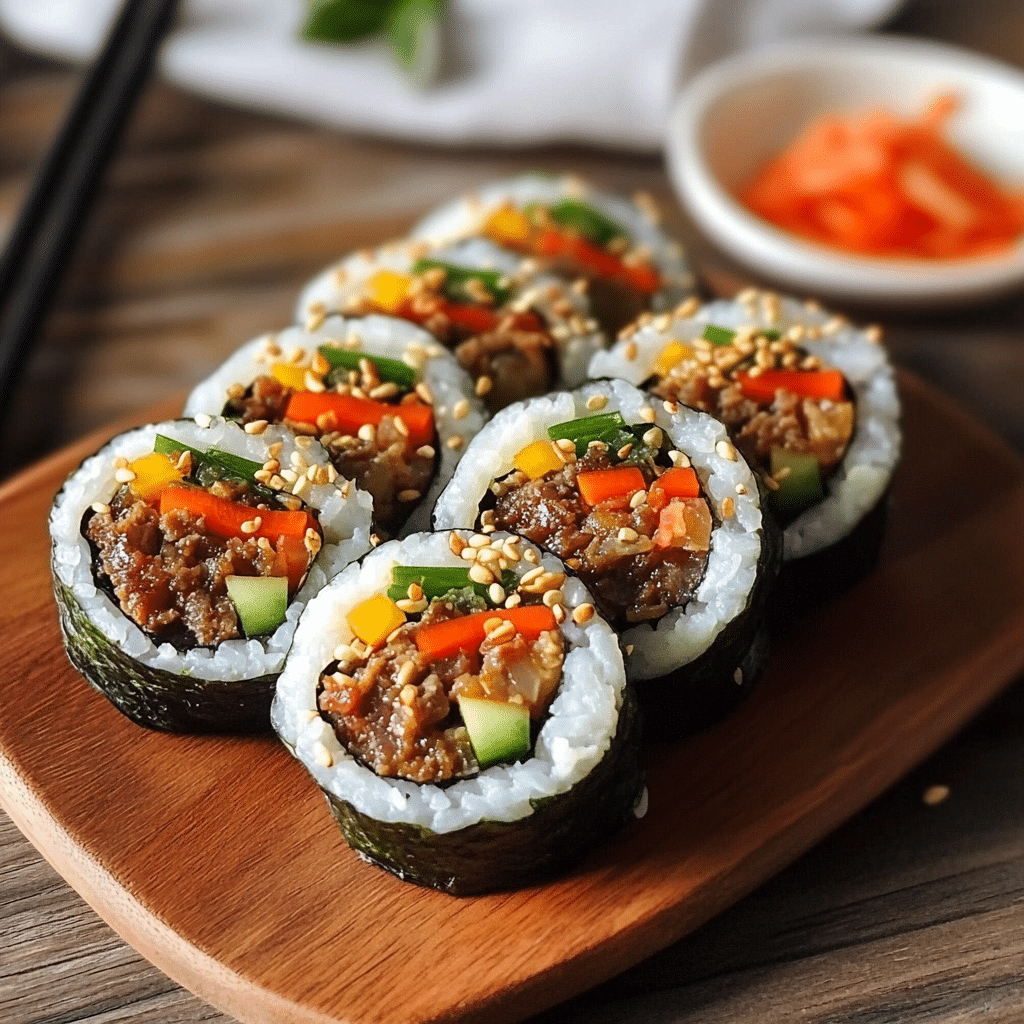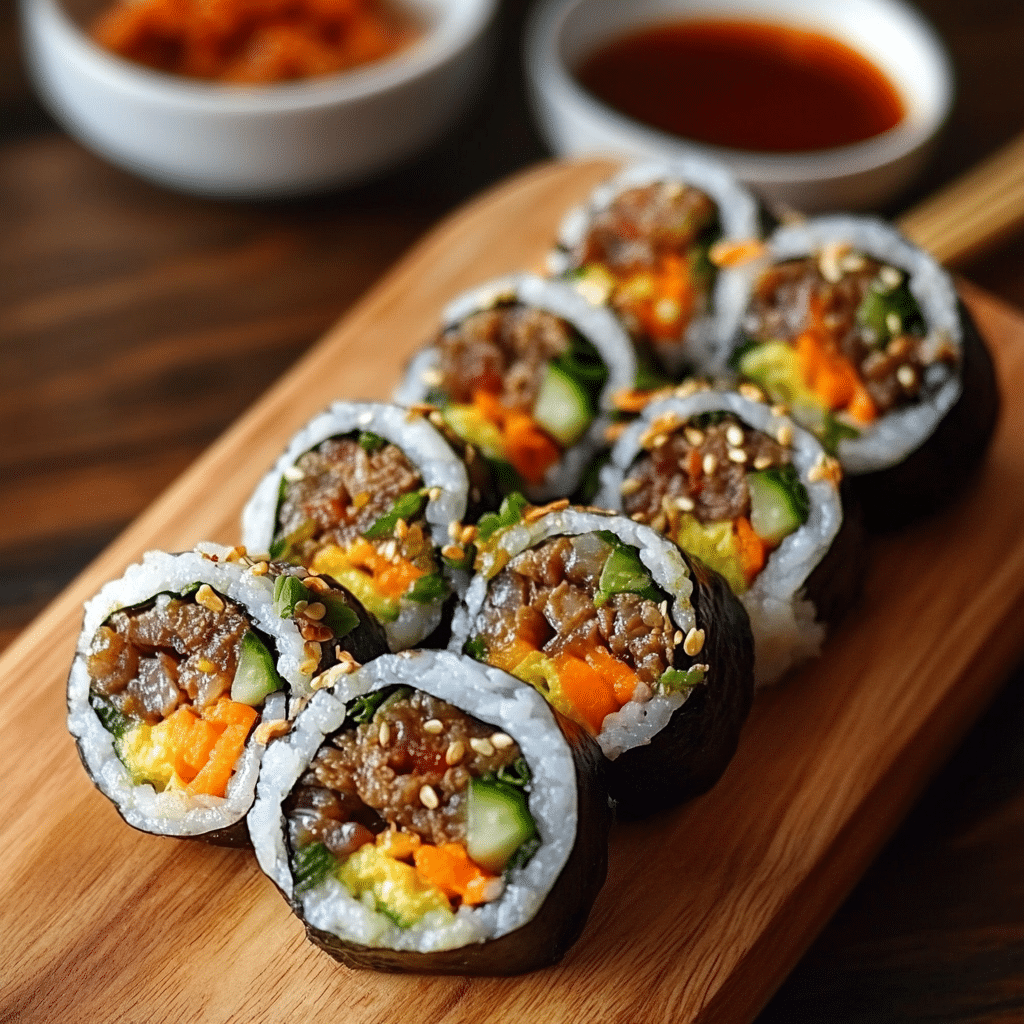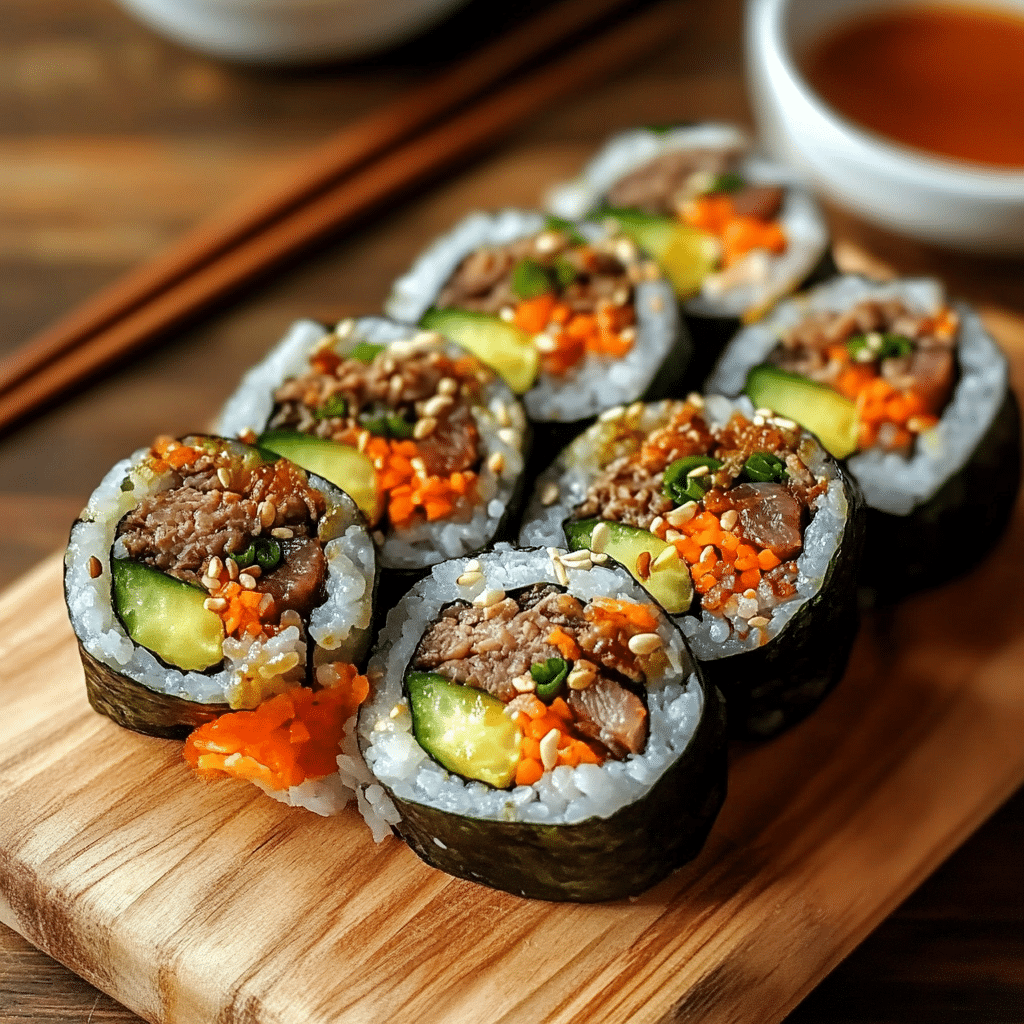Sushi is an internationally loved dish, but have you ever tried Korean Bulgogi Sushi Rolls? Combining the savory, sweet flavors of Korean bulgogi beef with the fresh ingredients of sushi, these rolls offer an exciting fusion of two distinct culinary traditions. The tender, marinated bulgogi beef is paired with vibrant, crisp vegetables and seasoned rice, all wrapped in a sheet of dried seaweed. It’s an innovative take on sushi that’s both delicious and fun to make.
The versatility of bulgogi makes it a perfect match for sushi rolls, as its deep flavor complements the mildness of the other ingredients. The addition of pickled yellow radish, seasoned burdock root, and fresh cucumber adds crunch and a balance of tart and savory notes. With the simplicity of the sushi rice and the depth of flavor from the bulgogi, these rolls offer a delicious and satisfying bite in every piece. Whether you’re a sushi enthusiast or a bulgogi fan, this recipe is sure to become a favorite.
Why You’ll Love This Recipe
- Fusion Flavors: A unique mix of Korean bulgogi beef and traditional sushi ingredients.
- Quick & Simple: Despite the variety of ingredients, these rolls come together quickly with just a few easy steps.
- Fresh & Flavorful: The freshness of cucumber, carrot, and perilla leaves balances the rich, savory bulgogi beef.
- Customizable: You can adjust the fillings to suit your taste—add more veggies, less meat, or even a different protein.
- Fun to Make: Rolling sushi can be a fun and interactive cooking activity, whether you’re cooking solo or with family and friends.
Ingredients
Main
- Dried seaweed sheets
- Steamed short-grain rice (cooled down)
- Toasted sesame seeds
- Perilla leaves (stems removed)
- Bulgogi (Korean marinated beef, cooked)
- Yellow radish pickle (strips)
- Seasoned burdock root (strips)
- English or Lebanese cucumber (julienned)
- Medium carrot (julienned)
- Sesame oil
Rice Seasoning
- Rice vinegar
- White sugar
- Fine sea salt
Variations
- Vegetarian Option: Replace the bulgogi beef with grilled tofu or tempeh for a vegetarian version.
- Different Vegetables: Feel free to add avocado, bell peppers, or sprouts for extra texture and flavor.
- Spicy Kick: Add a drizzle of sriracha or spicy mayo to the inside of the rolls for a heat boost.
- Pickled Veggies: Experiment with different pickled vegetables, such as pickled carrots or kimchi, for an extra punch of flavor.
How to Make the Recipe
Step 1: Prepare the Rice
Start by seasoning the cooled short-grain rice. In a small bowl, combine rice vinegar, sugar, and sea salt. Microwave the mixture for about 30 seconds to dissolve the sugar, then mix it into the cooled rice. Make sure the rice is seasoned evenly and set it aside to cool further if needed.
Step 2: Prepare the Filling Ingredients
Julienne the cucumber and carrot. Remove the stems from the perilla leaves, and slice the yellow radish pickle and seasoned burdock root into thin strips. Make sure the bulgogi beef is cooked and ready to go.
Step 3: Set Up Your Rolling Station
Place a bamboo sushi mat on a flat surface. Lay a sheet of dried seaweed on the mat, shiny side down. Lightly brush the seaweed with sesame oil to enhance the flavor.
Step 4: Spread the Rice
Spread a thin layer of seasoned rice over the seaweed, leaving about 1 inch of space at the top for sealing. Press the rice down gently, but don’t pack it too tightly.
Step 5: Add the Fillings
Place a few strips of bulgogi beef, perilla leaves, cucumber, carrot, yellow radish pickle, and burdock root in the center of the rice. Be careful not to overstuff the roll.
Step 6: Roll the Sushi
Using the bamboo mat, carefully lift the edge of the seaweed closest to you and begin rolling it over the filling, applying gentle pressure. Continue rolling, sealing the edge of the seaweed with a bit of water to keep it from unraveling.
Step 7: Slice and Serve
Once the roll is complete, use a sharp knife to slice it into 6–8 pieces. Sprinkle toasted sesame seeds over the top for added flavor and presentation.

Tips for Making the Recipe
- Sharp Knife: Use a sharp knife to cut the rolls, and clean the blade between each cut to avoid squishing the sushi.
- Rice Consistency: Make sure the rice is slightly sticky but not too wet. If it’s too wet, the rolls will be difficult to handle.
- Rolling Technique: Be gentle but firm when rolling the sushi to ensure a tight roll without breaking the seaweed.
- Fresh Ingredients: Use fresh, crunchy vegetables for the best texture and flavor in the rolls.
- Customize the Filling: Feel free to adjust the amount of bulgogi or other fillings based on your preference.
How to Serve
These Korean Bulgogi Sushi Rolls can be served as part of a larger sushi platter, alongside dipping sauces like soy sauce, sesame oil, or spicy mayo. You can also serve them with a side of pickled ginger or a simple salad to complete the meal.
Make Ahead and Storage
Storing Leftovers
If you have any leftover rolls, store them in an airtight container in the refrigerator for up to 24 hours. Sushi is best enjoyed fresh, so the texture of the rice may change if stored for too long.
Freezing
It is not recommended to freeze sushi rolls as the rice and vegetables may become soggy upon thawing.
Reheating
Sushi should be eaten cold or at room temperature. If necessary, let the leftovers sit out for a few minutes to warm slightly before serving.

FAQs
1. Can I use a different type of beef for bulgogi?
Yes, you can use chicken, pork, or even tofu as a substitute for the bulgogi beef.
2. Can I prepare the rolls ahead of time?
You can prepare the sushi rolls a few hours in advance, but it’s best to enjoy them fresh for the best texture.
3. What’s the best way to store leftover sushi?
Keep leftover sushi rolls in an airtight container in the fridge. They are best eaten within 24 hours.
4. Can I use frozen bulgogi?
If you’re using frozen bulgogi, be sure to fully thaw and reheat it before adding it to the rolls.
5. What is perilla leaf, and can I substitute it?
Perilla leaves are a type of aromatic herb used in Korean cooking. If you can’t find them, you can substitute with fresh shiso leaves or even spinach for a milder flavor.
6. Can I use a different type of sushi rice?
It’s best to use short-grain sushi rice as it has the right stickiness, but you can use other types of rice in a pinch.
7. Can I use regular pickles instead of yellow radish pickle?
Yellow radish pickle adds a unique flavor, but you can use regular pickles as a substitute if desired.
8. How do I prevent the rice from sticking to my hands when spreading it on the seaweed?
Lightly wet your hands with water to prevent the rice from sticking.
9. Can I add spicy mayo to these rolls?
Yes, you can drizzle spicy mayo on top or add it inside the roll for a bit of heat.
10. How do I keep the rolls from falling apart?
Make sure your rolls are tightly wrapped, and use a little water to seal the edge of the seaweed.
Conclusion
Korean Bulgogi Sushi Rolls bring together the best of Korean flavors and traditional sushi techniques. With tender bulgogi beef, vibrant vegetables, and seasoned rice, these rolls offer a delicious and creative twist on the classic sushi roll. Whether you’re a seasoned sushi maker or new to rolling sushi at home, this recipe is a fun and flavorful way to enjoy a fusion of cuisines.
Print
Korean Bulgogi Sushi Rolls
- Total Time: 40 minutes
- Yield: 4 servings 1x
Description
Korean Bulgogi Sushi Rolls combine the flavors of traditional sushi with savory Korean bulgogi beef. This fusion dish features tender bulgogi beef, crunchy vegetables, and seasoned rice all wrapped in crisp seaweed. Perfect for a unique dinner or impressive appetizer, these rolls offer a delicious twist on classic sushi.
Ingredients
For the Rolls:
-
7 dried seaweed sheets
-
5 1/2 cups steamed short-grain rice, cooled down (see note above)
-
1 tablespoon toasted sesame seeds
-
14g Perilla leaves (stems removed)
-
500g Bulgogi (Korean marinated beef), cooked
-
7 strips yellow radish pickle (see note above)
-
14 strips seasoned burdock root (see note above)
-
1 English or Lebanese cucumber (270g / 10 ounces), seeds removed and julienned
-
1 medium carrot (220g / 8 ounces), julienned (use a mandoline slicer for best results)
-
1 to 2 tablespoons sesame oil
For the Rice Seasoning:
-
3 tablespoons rice vinegar
-
2 tablespoons white sugar
-
1 teaspoon fine sea salt
Instructions
-
Prepare the Rice:
-
Mix rice vinegar, sugar, and sea salt in a small bowl. Microwave for about 30 seconds to dissolve the sugar (alternatively, use 3 tablespoons of pre-made sushi seasoning sauce).
-
Drizzle the seasoning mixture over the cooled steamed rice and mix gently until evenly coated. Set aside.
-
-
Prepare the Fillings:
-
Julienne the cucumber and carrot into thin strips.
-
Cook the bulgogi (marinated beef) if not already cooked, and slice it into strips.
-
Prepare the yellow radish pickle and burdock root, slicing them into strips if not already done.
-
-
Assemble the Sushi Rolls:
-
Place a bamboo sushi mat on a flat surface and set a sheet of dried seaweed on top.
-
Spread an even layer of seasoned rice onto the seaweed sheet, leaving about an inch at the top edge.
-
Arrange a few strips of bulgogi, cucumber, carrot, yellow radish pickle, and burdock root horizontally across the rice.
-
Add a few Perilla leaves for a fresh flavor boost, then sprinkle with toasted sesame seeds.
-
-
Roll the Sushi:
-
Carefully lift the edge of the sushi mat closest to you and begin rolling the sushi away from you, pressing gently to form a tight roll.
-
Once you reach the top edge of the seaweed, seal it with a small amount of water.
-
-
Slice and Serve:
-
Using a sharp knife, slice the roll into bite-sized pieces.
-
Optionally, drizzle with sesame oil before serving.
-
Notes
-
Perilla leaves and seasoned burdock root are optional but add authenticity and flavor. You can find these ingredients at Korean or Asian grocery stores.
-
If you don’t have access to the yellow radish pickle or burdock root, you can substitute with thin strips of pickled vegetables or radish.
- To make the rice preparation easier, you can use store-bought sushi seasoning sauce.
- Prep Time: 30 minutes
- Cook Time: 10 minutes
- Category: Main Course
- Method: No-Bake
- Cuisine: Korean


